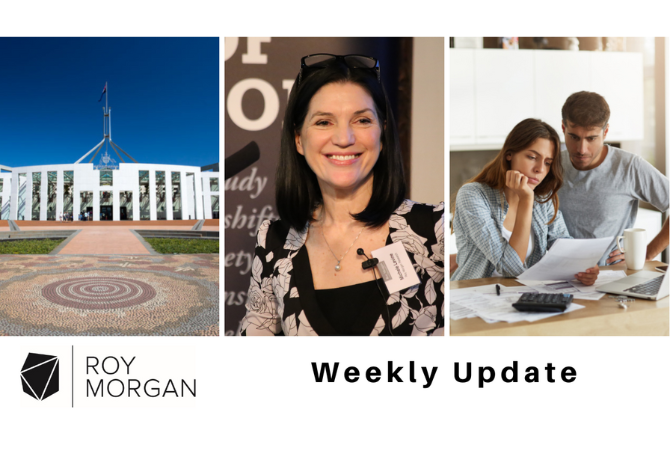Roy Morgan Update October 21, 2025: Federal Vote, Consumer Confidence and Mortgage Stress

In this week's Market Research Update, we present the latest data on Federal Vote, Consumer Confidence and Mortgage Stress.
Welcome to the Roy Morgan Weekly update.
I’m Julian McCrann, Roy Morgan Poll manager, stepping in today for Roy Morgan CEO Michele Levine who is unavailable.
And starting today, the latest Roy Morgan Poll conducted in October with an Australia-wide cross-section of 4,908 electors – found;
The ALP up 1% to 35%, One Nation up 2.5% to 12%, and the Greens up 1% to 13%, however the Coalition dropped 3% to 27%, and Independents/ Other Parties down 1.5% to 13%.
On a State basis support for the ALP increased significantly in New South Wales and Victoria while One Nation support surged in all States – at least 10% in all States except Victoria.
Coalition support fell in all States except Western Australia.
These results are not surprising considering the political situation. Prime Minister Anthony Albanese had a successful trip to the United States to address the United Nations for the first time in late September.
In addition, there was continued disunity in the Coalition throughout the last month.
Senator Jacinta Nampijinpa Price was sacked by Opposition Leader Sussan Ley in mid-September, in early October Liberal MP Andrew Hastie resigned from the shadow cabinet citing disagreement with the Coalition’s immigration policy, and over the weekend the former leader of the Nationals, Barnaby Joyce, announced his intention not to re-contest his seat for the National Party.
Joyce has also admitted to discussing a potential move to the One Nation party with Pauline Hanson.
The surge in support for One Nation in October appears to have come directly from disaffected former Coalition voters – some of whom were likely at widespread anti-mass immigration rallies over the weekend.
This is the highest level of support for One Nation for over 27 years since the party reached 13.5% support in a Roy Morgan Poll in August 1998.
Two-party preferred support for the ALP was up 1.5% to 57% well ahead of the Coalition on only 43%.
However, the latest Roy Morgan’s Government Confidence (whether people think the country is going in the right or wrong direction) shows not everything is going well for the Government and was virtually unchanged at only 80 in October.
53% of Australians say the country is ‘going in the wrong direction’ compared to only 33% that say the country is ‘going in the right direction’.
And now to consumer confidence. ANZ-Roy Morgan Consumer Confidence increased 1 point to 84.0.
The driver of the increase was more confidence about prospects for the Australian economy going forward.
In further good news, ANZ-Roy Morgan Inflation Expectations dropped 0.5% to 4.7%.
So, Australians are expecting annual inflation of 4.7% each year over the next two years.
And now to Mortgage Stress.
The latest Roy Morgan estimates show mortgage stress down in September, by 2%. Now 25.9% of Australians with a mortgage, are ‘At Risk’ of mortgage stress – an estimated 1.36 million Australians.
The decline in mortgage stress followed the Reserve Bank’s decision to cut interest rates in August to 3.6% and is the lowest level of mortgage stress since early 2023.
If the Reserve Bank cuts rates in early November, and again in December – by 0.25% at both meetings – all other things being equal – mortgage stress will be reduced in the months ahead.
These two interest rate cuts would lower mortgage stress by another 2% points to 23.9% of mortgage holders in Australia, or 1,256,000 – around 105,000 fewer people would be in Mortgage stress than there are now.
However, it is worth keeping in mind that as interest rates reduce, borrowers are able to access larger loans and to pay higher prices for homes than they were previously able to.
Although lowering interest rates lead to lower mortgage stress in the short-term for existing mortgage holders – human behaviour being what it is, and market dynamics being what they are, the follow on impact of people taking out larger loans than before can lead to a further increase in mortgage stress soon after.
These are all considerations the Reserve Bank needs to take into account when deciding on whether to cut interest rates again in the months ahead.
And now to some research undertaken into an exciting event for many celebrated at the end of this month – Halloween.
In research conducted in collaboration with the Australian Retailers Association we find that around one-in-five Australians (4.8 million) plan to celebrate Halloween.
Margin of Error
The margin of error to be allowed for in any estimate depends mainly on the number of interviews on which it is based. Margin of error gives indications of the likely range within which estimates would be 95% likely to fall, expressed as the number of percentage points above or below the actual estimate. Allowance for design effects (such as stratification and weighting) should be made as appropriate.
| Sample Size | Percentage Estimate |
| 40% – 60% | 25% or 75% | 10% or 90% | 5% or 95% | |
| 1,000 | ±3.0 | ±2.7 | ±1.9 | ±1.3 |
| 5,000 | ±1.4 | ±1.2 | ±0.8 | ±0.6 |
| 7,500 | ±1.1 | ±1.0 | ±0.7 | ±0.5 |
| 10,000 | ±1.0 | ±0.9 | ±0.6 | ±0.4 |
| 20,000 | ±0.7 | ±0.6 | ±0.4 | ±0.3 |
| 50,000 | ±0.4 | ±0.4 | ±0.3 | ±0.2 |
